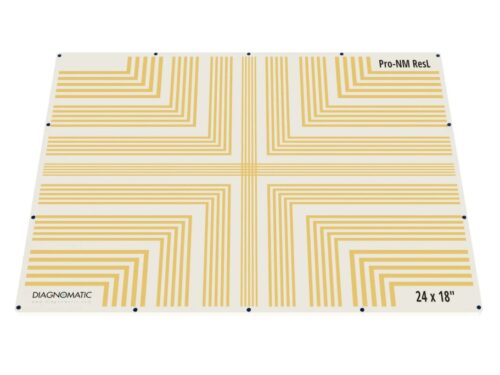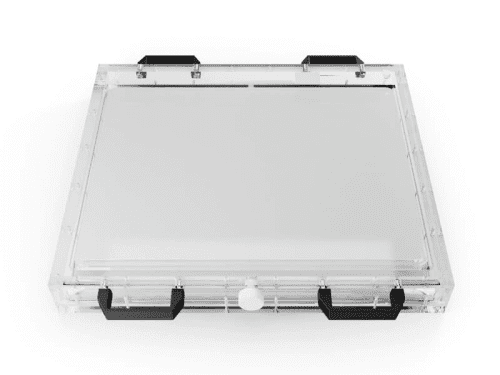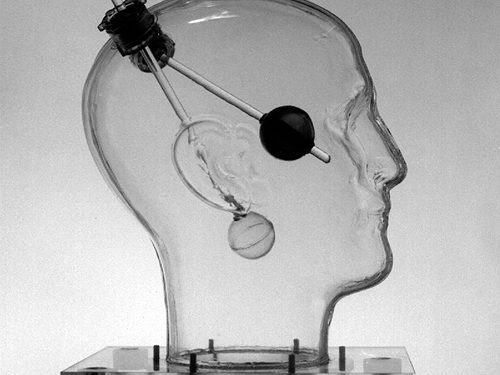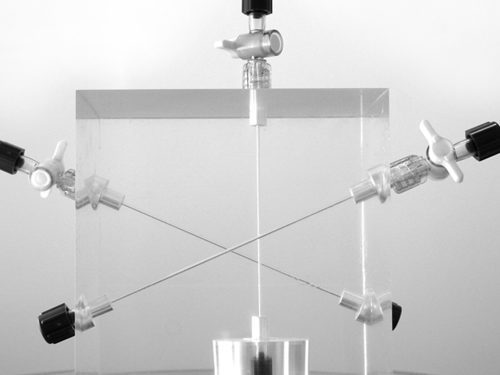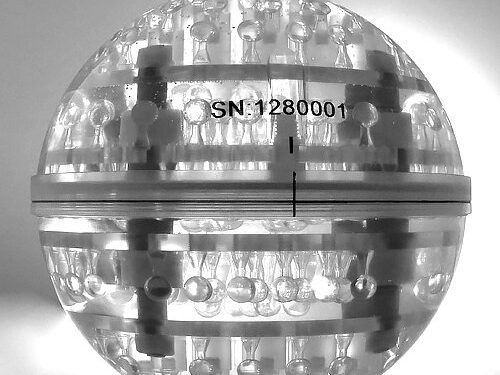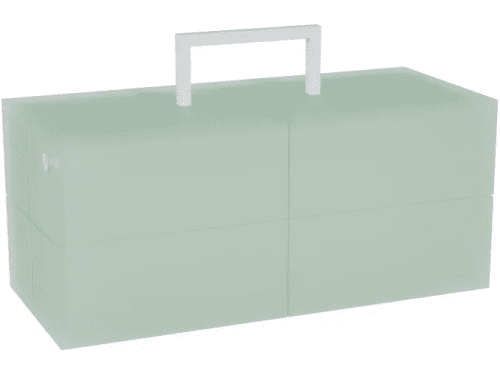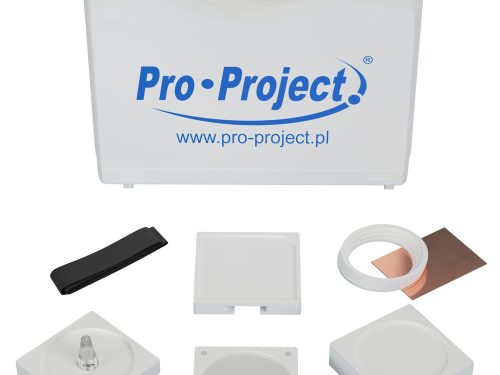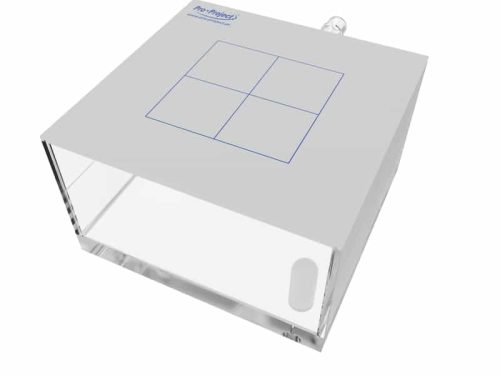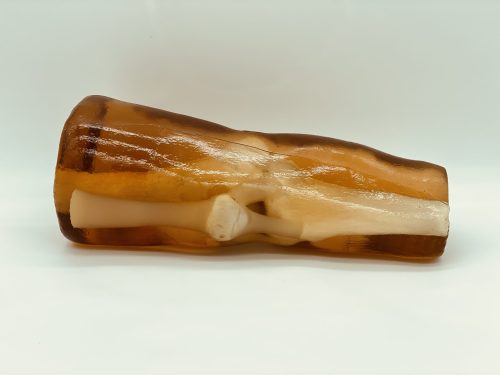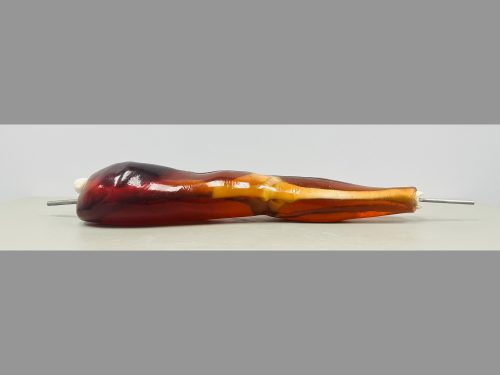-
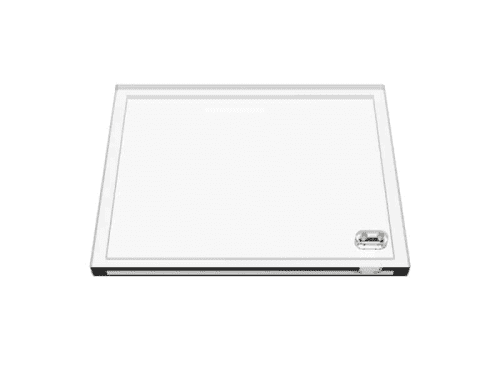 Flood phantoms provide a simple and efficient means of obtaining optimum camera performance with respect to uniformity of response over the entire crystal area. These phantoms are designed to be filled in horizontal position, thus preventing slight bulging caused by water pressure during vertical filling. Therefore, better uniformity in distribution of activity can be achieved.
Flood phantoms provide a simple and efficient means of obtaining optimum camera performance with respect to uniformity of response over the entire crystal area. These phantoms are designed to be filled in horizontal position, thus preventing slight bulging caused by water pressure during vertical filling. Therefore, better uniformity in distribution of activity can be achieved. -
 A simple phantom the quality assurance of geometric distortion and spatial resolution of gamma cameras. Array of holes, which when filled with activity, allows to measure point-to-point distances and Point Spread Function (PSF) - spatial resolution - at each point and its homogeneity across the entire Field of View.
A simple phantom the quality assurance of geometric distortion and spatial resolution of gamma cameras. Array of holes, which when filled with activity, allows to measure point-to-point distances and Point Spread Function (PSF) - spatial resolution - at each point and its homogeneity across the entire Field of View. -
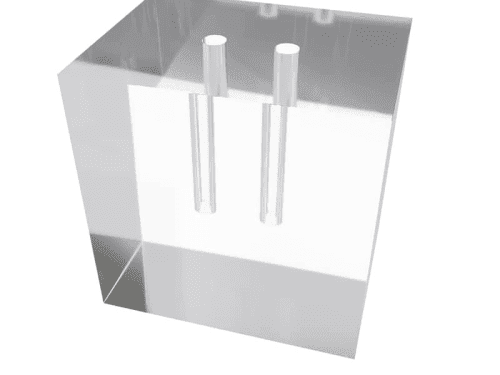 This scatter phantom simulates in-vivo forward and backscatter characteristics of 99mTc gamma rays for the extrinsic measurement of a scintillation camera’s deadtime. The phantom produces a spectrum typical of that observed from 99mTc in the myocardium. Reference: Ralph Adams, Gerald J. Hine, and C. Duane Zimmerman, “Deadtime Measurements in Scintillation Cameras Under Scatter Conditions Simulating Quantitative Nuclear Cardiography,” The Journal of Nuclear Medicine, 19 (1978), 538-544.
This scatter phantom simulates in-vivo forward and backscatter characteristics of 99mTc gamma rays for the extrinsic measurement of a scintillation camera’s deadtime. The phantom produces a spectrum typical of that observed from 99mTc in the myocardium. Reference: Ralph Adams, Gerald J. Hine, and C. Duane Zimmerman, “Deadtime Measurements in Scintillation Cameras Under Scatter Conditions Simulating Quantitative Nuclear Cardiography,” The Journal of Nuclear Medicine, 19 (1978), 538-544. -
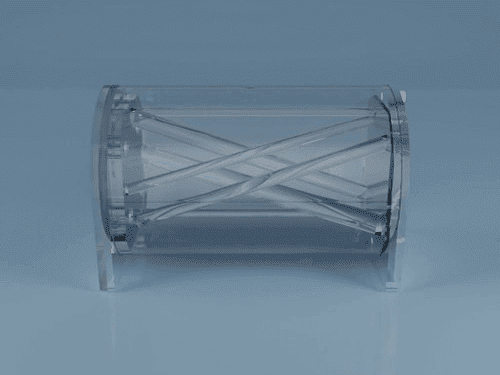 The Phantom designed for a simple and cost effective verification of image alignment and distortion in hybrid scanning systems like PET/CT or NM/CT. It consists of a cylinder that can be filled with a variety of fluids. Several non-parallel rods of varying diameter and at certain angles in relation to the phantom’s axes run the entire length of the cylinder.
The Phantom designed for a simple and cost effective verification of image alignment and distortion in hybrid scanning systems like PET/CT or NM/CT. It consists of a cylinder that can be filled with a variety of fluids. Several non-parallel rods of varying diameter and at certain angles in relation to the phantom’s axes run the entire length of the cylinder. -
 This phantom can be used to check the alignment of the internal and external lasers to the radiographic centre of CT and PET/CT units and to verify lateral gantry angle. It can also be used with accelerator units to check vertical and lateral gantry angles, laser alignment and vertical table movement.
This phantom can be used to check the alignment of the internal and external lasers to the radiographic centre of CT and PET/CT units and to verify lateral gantry angle. It can also be used with accelerator units to check vertical and lateral gantry angles, laser alignment and vertical table movement. -
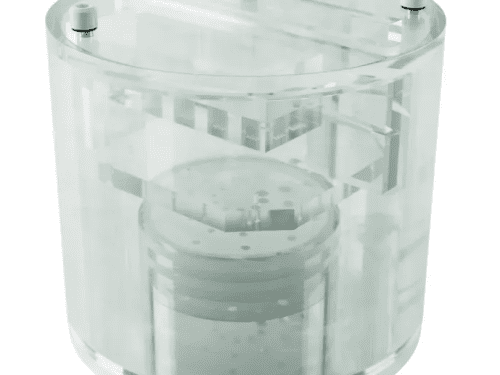 ACR accredited Medium MRI phantom for comprehensive evaluation of critical imaging parameters of magnetic resonance imaging (MRI) in a time efficient manner. The phantom can be used for the measurement of absolute values for calibration purposes. However, its design is optimized for time efficient daily quality assurance too.
ACR accredited Medium MRI phantom for comprehensive evaluation of critical imaging parameters of magnetic resonance imaging (MRI) in a time efficient manner. The phantom can be used for the measurement of absolute values for calibration purposes. However, its design is optimized for time efficient daily quality assurance too. -
 Large MRI phantom for comprehensive evaluation of critical imaging parameters of magnetic resonance imaging (MRI) in a time efficient manner. The phantom can be used for the measurement of absolute values for calibration purposes. However, its design is optimized for time efficient daily quality assurance too.
Large MRI phantom for comprehensive evaluation of critical imaging parameters of magnetic resonance imaging (MRI) in a time efficient manner. The phantom can be used for the measurement of absolute values for calibration purposes. However, its design is optimized for time efficient daily quality assurance too. -
 An integrated MR QA system for MR guided surgery and radiotherapy MRI manufacturers have made great strides in reducing MR system distortion. Maintaining acceptable levels of distortion relies on properly controlling a long chain of conditions. It is critical to have a robust system of quality control for key imaging performance characteristics in order to detect significant deviations before they affect clinical operations.
An integrated MR QA system for MR guided surgery and radiotherapy MRI manufacturers have made great strides in reducing MR system distortion. Maintaining acceptable levels of distortion relies on properly controlling a long chain of conditions. It is critical to have a robust system of quality control for key imaging performance characteristics in order to detect significant deviations before they affect clinical operations. -
 This stability (agar) phantom consists of a cylindrical phantom and agar material inside. Using this phantom a Signal to Noise Ratio, Signal Fluctuation to Noise Ratio, drift, and other imaging measures over a 100-volume or 200-volume fMRI scan can be performed. The agar phantom has characteristics similar to the T2 measures of a human head, but provides no change in signal. The T1 and T2 characteristics of the agar phantom at 3T are ~900 ms T1 and 30 ms T2.
This stability (agar) phantom consists of a cylindrical phantom and agar material inside. Using this phantom a Signal to Noise Ratio, Signal Fluctuation to Noise Ratio, drift, and other imaging measures over a 100-volume or 200-volume fMRI scan can be performed. The agar phantom has characteristics similar to the T2 measures of a human head, but provides no change in signal. The T1 and T2 characteristics of the agar phantom at 3T are ~900 ms T1 and 30 ms T2. -
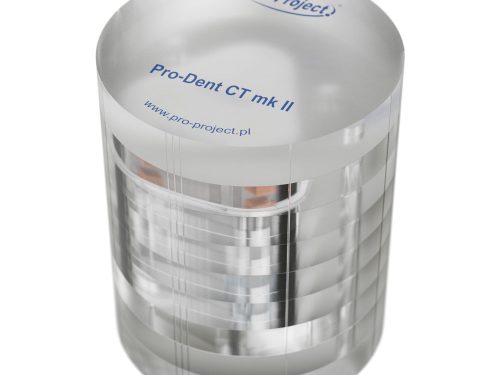 The new Pro-Dent CT mk II phantom is a versatile quality control tool of dental Cone-Beam CT, Dental Volume Tomography (DVT) and other 3D imaging devices according to the Radiation Protection Report no 172 by SEDENTEXCT. The phantom consists of a main PMMA cylinder that houses modules with different test objects. Thanks to this design, you can perform tests with devices with a small FOV at different positions in the 160 mm phantom.
The new Pro-Dent CT mk II phantom is a versatile quality control tool of dental Cone-Beam CT, Dental Volume Tomography (DVT) and other 3D imaging devices according to the Radiation Protection Report no 172 by SEDENTEXCT. The phantom consists of a main PMMA cylinder that houses modules with different test objects. Thanks to this design, you can perform tests with devices with a small FOV at different positions in the 160 mm phantom. -
 The Pro-RT ED phantom is used to account for tissue heterogeneity in radiotherapy treatment planning. It can be used to define the precise correlation of CT data to the electron density of various tissues. The phantom consists of two nested disks that represent the head and abdomen. Nine different tissue equivalent electron density plugs can be positioned at 17 different locations within the scan field. Included is a water vial plug that can be filled with any fluid. Optional distance marker plugs enable quick assessment of the CT scanner’s distance measurement accuracy.
The Pro-RT ED phantom is used to account for tissue heterogeneity in radiotherapy treatment planning. It can be used to define the precise correlation of CT data to the electron density of various tissues. The phantom consists of two nested disks that represent the head and abdomen. Nine different tissue equivalent electron density plugs can be positioned at 17 different locations within the scan field. Included is a water vial plug that can be filled with any fluid. Optional distance marker plugs enable quick assessment of the CT scanner’s distance measurement accuracy. -
 Pro-RT IsoBeam This is a multifunctional, precision quality assurance tool for daily, weekly or monthly quality assessments of all mechanical and geometrical treatment parameters of linear accelerators or teletherapy units. It is designed to easily and accurately check collimator isocentricity, gantry isocentricity, table isocentricity, collimator field size accuracy, radiation/light field congruence, isocenter rotational stability, ODI accuracy and laser light alignments.
Pro-RT IsoBeam This is a multifunctional, precision quality assurance tool for daily, weekly or monthly quality assessments of all mechanical and geometrical treatment parameters of linear accelerators or teletherapy units. It is designed to easily and accurately check collimator isocentricity, gantry isocentricity, table isocentricity, collimator field size accuracy, radiation/light field congruence, isocenter rotational stability, ODI accuracy and laser light alignments. -
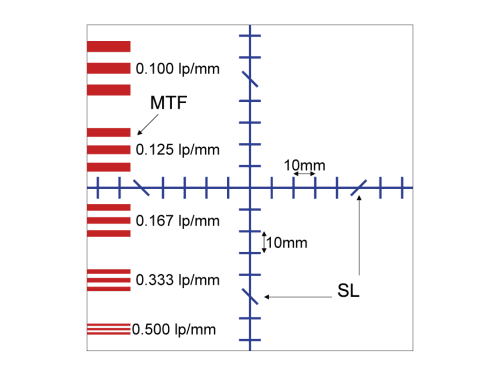 This phantom is designed for quality control of a CT simulator, which usually consists of a CT scanner, virtual symulator software and a laser marking device (marking the centre of target volume). Since geometrical planning is the core of CT simulation, periodic quality control is essential for maintaining optimum image quality and patient care. The phantom allows performing detailed geometry and table movement tests as well as image quality assessment - low contrast resolution and high contrast detectability.
This phantom is designed for quality control of a CT simulator, which usually consists of a CT scanner, virtual symulator software and a laser marking device (marking the centre of target volume). Since geometrical planning is the core of CT simulation, periodic quality control is essential for maintaining optimum image quality and patient care. The phantom allows performing detailed geometry and table movement tests as well as image quality assessment - low contrast resolution and high contrast detectability. -
 Simple to use and economic tool to perform true spatial alignment and coincidence tests on IGRT systems. Pro-RT Align-Cube contains engraved markings on the exterior and radiographic markers inside. The isocenters of both the OBI and the EPID can be checked for true spatial alignment and coincidence with that of the treatment beam. The phantom ensures the accuracy of linacs’ image-guidance systems, including CBCT, x-ray volumetric imaging (XVI) and on-board imaging (OBI). It can be used to test: 3D cone beam registration kV and MV system coincidence kV and MV projection images laser and light field coincidence weekly remote table adjustments
Simple to use and economic tool to perform true spatial alignment and coincidence tests on IGRT systems. Pro-RT Align-Cube contains engraved markings on the exterior and radiographic markers inside. The isocenters of both the OBI and the EPID can be checked for true spatial alignment and coincidence with that of the treatment beam. The phantom ensures the accuracy of linacs’ image-guidance systems, including CBCT, x-ray volumetric imaging (XVI) and on-board imaging (OBI). It can be used to test: 3D cone beam registration kV and MV system coincidence kV and MV projection images laser and light field coincidence weekly remote table adjustments -
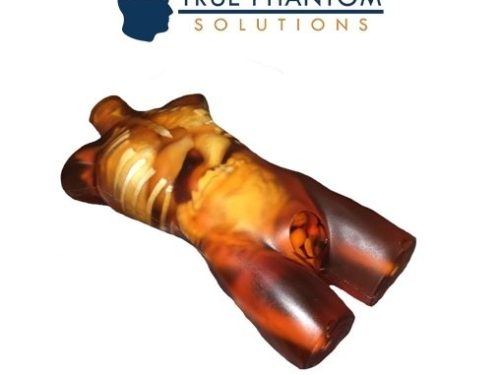 The Adult Full Body Phantom (with Muscles) is a versatile training product compatible with X-Ray CT and MRI. It is primarily used for training and demonstrating patient positioning techniques in radiology, providing hands-on experience with diagnostic imaging techniques. The skeleton is made of individually cast bones with adjustable properties, and the phantom can be customized with various pathologies. It is available in translucent or skin-coloured versions.
The Adult Full Body Phantom (with Muscles) is a versatile training product compatible with X-Ray CT and MRI. It is primarily used for training and demonstrating patient positioning techniques in radiology, providing hands-on experience with diagnostic imaging techniques. The skeleton is made of individually cast bones with adjustable properties, and the phantom can be customized with various pathologies. It is available in translucent or skin-coloured versions. -
 Adult Human Torso (Dynamic) with a beating heart and breathable lungs is a lifelike, anatomically realistic, from neck to pelvic area phantom/simulator with all the essential organs present inside. This phantom is compatible with MRI and X-Ray/CT, and it is an ideal tool for applications such as angiography. The organs are made from realistic urethane-based tissue-mimicking materials, and the bones are made from a patented ceramic-reinforced epoxy-based composite material. The skeleton is assembled from individually cast bones with vertebrae that have a realistic three-layered structure and inner porosity. In terms of MRI applications, the phantom tissues have realistic T2 relaxation time values, which makes this product to be the best fit for any T2-weighted MRI imaging methods. Very good results can also be achieved with Proton Density imaging methods. The phantom can still be imaged with T1-weighted methods, but the T1 values are less realistic, and they are within the range of about 100 ms. The design of this phantom includes a realistic heart with all major heart vessels and internal heart chambers. The TPS heart pump is included with this phantom, and it enables the realistic heartbeat and motion of heart walls. The TPS lung pump is also included to provide lifelike breathing motion in the torso.
Adult Human Torso (Dynamic) with a beating heart and breathable lungs is a lifelike, anatomically realistic, from neck to pelvic area phantom/simulator with all the essential organs present inside. This phantom is compatible with MRI and X-Ray/CT, and it is an ideal tool for applications such as angiography. The organs are made from realistic urethane-based tissue-mimicking materials, and the bones are made from a patented ceramic-reinforced epoxy-based composite material. The skeleton is assembled from individually cast bones with vertebrae that have a realistic three-layered structure and inner porosity. In terms of MRI applications, the phantom tissues have realistic T2 relaxation time values, which makes this product to be the best fit for any T2-weighted MRI imaging methods. Very good results can also be achieved with Proton Density imaging methods. The phantom can still be imaged with T1-weighted methods, but the T1 values are less realistic, and they are within the range of about 100 ms. The design of this phantom includes a realistic heart with all major heart vessels and internal heart chambers. The TPS heart pump is included with this phantom, and it enables the realistic heartbeat and motion of heart walls. The TPS lung pump is also included to provide lifelike breathing motion in the torso.

